A little something to go with your Rolex and gold chains.
None other than the gold plated, bejewelled Minox DC1011.
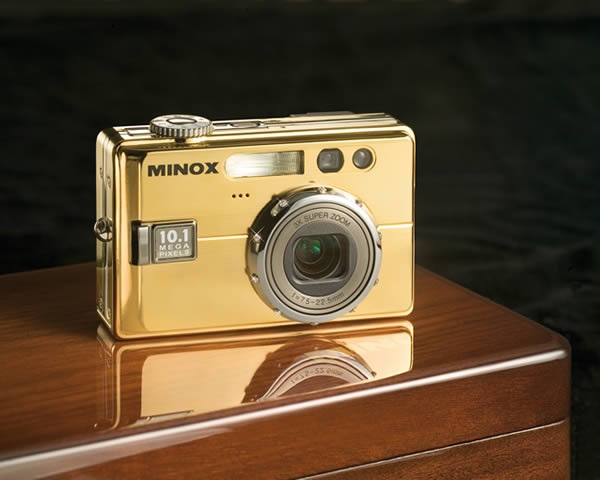
If you have to ask ‘How much’, you cannot afford it, which is probably just as well.
A little something to go with your Rolex and gold chains.
None other than the gold plated, bejewelled Minox DC1011.

If you have to ask ‘How much’, you cannot afford it, which is probably just as well.
Why the world needs more Jonathan Ive-like engineers – or Leica M2 viewfinders.
As this is a very long entry, in the true ergonomic spirit here’s a sound file of this piece that you can listen to or move to your iPod for use in the car, precluding the need to read and maximizing the use of your time. It’s just over thirteen minutes in length.
When I graduated top of my class from University College London’s engineering school in 1973, not least of the classes I look back on with unalloyed joy was the one taught by Professor Alec Rodger. Already an old man, Rodger was the dean of occupational psychology – what we now call ergonomics – in the United Kingdom. His pioneering work on man-machine interfaces in WWII and subsequent studies of men in confined areas (he had himself locked in hard-core Brixton prison for six months to study the inmates!) made him the number one man in the field on the other side of the Atlantic.
I contemplated ergonomics as a career but there was no money to be made at it in a country that regarded engineers with disdain trending to dislike, and accorded the same status (and pay) to a laborer bashing in railroad ties as to the guy designing turbines for Rolls Royce aircraft engines. So I took the easy way out and became a finance guy. Do what you have to do for a living and enjoy your hobbies in your spare time.
Ergonomics are very much on my mind as I design the new eBook I am working on with a fellow photographer. The look and feel of the screens, the colors used, the menu system – all vital to an enjoyable reading experience. As if taking the pictures for the book was not hard enough….
Which segues naturally into some of the lousy ergonomics of things that plague us daily.
Ever tried to open a Coke can without getting sprayed?
Ever tried to work that remote with dozens of rarely used buttons in the dark?
Ever locked yourself out of your car?
Struggled to get a lid off a jar?
Tried to open the new box of breakfast cereal and actually get the re-closeable slot to work?
Been deafened by your electric shaver?
Scalded yourself on the water from the hot tap?
Of course you have. All examples of bad ergonomic design.
I was reminded of these frustrations when reading about Jonathan Ive. Most have never heard of him. Yet when I tell you he has been the designer of the exteriors of most Apple products for two decades, aided by his famously obsessive boss, Steve Jobs, I think you will agree that Ive – a self-effacing publicity-shy Englishman – is the greatest ergonomic engineer of modern times. The original, fun iMac with its translucent colored casing, the G4 iMac with the ‘screen on a stick’, the iPod with the inspired click wheel, and, coming soon, the iPhone which will finally make a cell phone easy to use, well, you get the idea. He has also attacked the remote control with Front Row, using a screen and a simple remote to control your gear.
All of this naturally got me thinking about ergonomics and cameras. As with other areas of design, there’s more bad than good, but here is a short list of stand-outs – good and bad – that I have encountered over the past few decades of taking pictures. My comments are focused on the simple desire that the machine that is the camera offers as little interference with the job of taking pictures as is possible through good ergonomic design.
First, some real stinkers.
The advance lever on the Leicaflex SL. Unless you have fingers like ET, there is no way you are going to advance the film with one clean stroke at eye level. First, the stroke is way too long. Second, the lever, if released, will fly back to a flush position with the top plate as the detent is too weak. And finally, in doing so, it will whack you in the eye. A clear stinker amongst stinkers.
The baseplate on the Leica M. First, the tripod bush is at the extreme edge rather than in line with the lens. Second, when you are snapping away in the rice paddies of Cambodia or wherever, and run out of film, you have to find somewhere to put the removable baseplate while you futz with the removable take-up spool and try to thread the new film into that horror. Then grasping the baseplate by its thin edges, you try to place it over the end peg before swinging it shut. You would think that after 50 years (the first M came out in the early-1950s) they would have learned to get this right. But no. Not a bit of it. What do you get when you shell out megabucks on the new Leica M8 digital? Why, a removable baseplate of course! You have to remove it to get at the card or battery. OK, so they got the tripod bush moved, but someone at Leica needs to have a discussion with a baseball bat-wielding user.
The removable back on the Nikon F. Nikon stole this one from Zeiss and its famed line of Contax and Contarex cameras. The sole purpose, best as I can tell, was to make the Leica M user feel good as every Nikon F user was dropping his baseplate in the mud of some war torn location.
Jump to the twenty-first century and nothing changes. Or maybe it does – for the worse.
Has anyone at Canon actually tried to use the LCD screen on the 5D in daylight? They might like to try, as it’s simply useless. Anything more than room lighting and it washes out. Not so great when you are trying to make some change in its interminable menus – another ergonomic disaster. And, adding insult to injury, there’s a dumb on-off switch which has two ‘on’ positions just to keep you confused (the second allows exposure compensation to be set but you would never work that out from the instruction book) and a myriad of small, confusingly labeled buttons to get in the way of picture-taking. Oh! and lest I forget, strap lugs so poorly designed that you wonder why they bothered, unless they were trying to match the design of the equally inept, not to mention gauche, camera strap provided with the 5D.
The advent of digital cameras has seen some new lows in ergonomics. In a flashback to the days of hi-fi, manufacturers have decided to compete on who has the most menu options. What they should be doing is competing on the basis of who has least. And what’s with the trend to getting rid of viewfinders and replacing them with unreadable screens? You either glue one on or snap away not knowing what the devil you are pointing the camera at; which, I suppose, may be appropriate for the majority of users. You see them everywhere, holding the camera at arm’s length (great for shake reduction) squinting away, trying to make sense of it all. Add interminable shutter lag on most of these cameras and you have nothing so much as a costly paperweight. Heck, suddenly that Nikon F back doesn’t seem so bad.
So what about the great things, the things Alec Rodger and Jonathan Ive would have been proud of?

Simply no question about #1, which I contend was the single greatest step in camera design before Kodak came up with the cassette loading Instamatic. The Leica M2 range/viewfinder. Not, not the M3 with its ever-present, clunky 50mm frame. And nothing from the M4 or later with multiple frames appearing at one time. Ergonomics 101. Never confuse the user with choices. No, the M2 got it so spectacularly right that it ranks as Number One in my book of ergonomic achievements. First, you only see the frame you are using. Sure you can switch in others temporarily, but they mercifully disappear when you let go of the toggle lever. Second, the frame lines are thin and unobtrusive. Third, they are almost electric in the way the are seemingly projected on the subject. Fourth, they move automatically towards the lens as focus distance falls, correcting parallax. Fifth – and this should probably be first – is that magnificent rangefinder. Its sharp edges allow focus by looking for broken lines at the periphery and its bright center allows normal coincident image focusing. Genius. Ive would be proud.
Leica got it ever so right again with the wind on lever to advance the film. From the early double stroke version in the first M3s (dictated by the belief that too rapid film advance would cause electrostatic sparks owing to the early glass pressure plate which held the film flat) to the later single stroke which still permitted a multi-stroke ratcheting action (something the Leicaflex SL sorely needs) it was almost perfect, and certainly beautiful to look at. Leitz’s design studies showed that, much as Ive does today, they had tried dozens of different designs before settling on the final one. Later, with the M4 they made it even better by adding a swiveling plastic tip. The looks were gone and the tip has been known to break off, but the feel was as right as it gets. No ET fingers needed, either.
Contax made a huge advance in the late 1930s with the integrated range/viewfinder in the Contax II and later cameras. The rangefinder patch lacked the sharp outline of the Leica M, so only coincident image focusing was possible, and there were no brightline frames, but it was a miracle of optical engineering for the time.
Leica M rangefinder bodies and the Pentax Spotmatic, an early TTL metering SLR, share the prize for how the camera feels in the hands, even if the Pentax’s lovely to behold advance lever had too long a throw. Both fit the hands just so – small hands, large hands, it makes no difference. The sheer sensuality of the fit is a master stroke of ergonomics.
When it comes to focusing lenses, many have tried to fix the problem of having to grip the focus ring from below; for the rangefinder user this is mandated as he must avoid blocking the finder window, and all users benefit from the enhanced stability conferred by a below-the-lens focus grip. Tell that to the poor folks trying to see their digital LCD screens at arm’s length. Leitz had some nice efforts with their 50mm and wider lenses where they fitted a small tab, the idea being that the user would grasp the camera firmly with both hands and focus with an extended left index finger under the lens. Of course, many users didn’t get it and you still see them focusing their 35mm lenses – which lack a conventional focus collar – by gingerly grasping the little lever with a detached right hand….
Zeiss tried a transversely mounted focus ring on some of their exotic lenses for the Contarex (much as they tried the focus wheel on the earlier Contax), but it was a gimmick slated to fail. The user needed a third hand to make sense of the arrangement. Leica made a magnificent effort with their long follow-focus lenses – first the 400mm and 560mm f/5.6 Telyts and later the more compact f/6.8 variants. Focusing is by a trombone action with a release button operated by the left thumb. Remarkably effective as long as you keep the trombone properly lubricated to avoid stiction. Once autofocus came along the need for any attention to manual focusing pretty much fell by the wayside, though some smart DSLR makers allow manual override by providing a traditional focus collar. Very nice to have. The one on my 200mm f/2.8 Canon ‘L’ lens is a joy to use, by way of example, and comes in very handy with moving subjects. Too bad they got rid of the built-in lens hood.
And speaking of lens hoods, well, they are largely obsoleted by modern lens coatings and rarely well executed in any case. Once again, Leitz with its inverted, funky looking hoods for the 50mm and shorter lenses made a good go of it, even if the hood could no longer be reversed on the lens for compact storage, but whoever designed the monstrosity that masquerades as a hood for the magnificent, compact 21mm f/2.8 Asph Elmarit, should be shot. The one for the 35mm Asph Summicron, by contrast, is a wonder to use and behold. Whether it’s actually of any use I’m not so sure.

So there are a few thoughts on ergonomics.
The Panasonic Lumix L1 is a catastrophe
Much as I predicted a couple of months back the Panasonic Lumix L1 which has just hit the market is nothing short of a catastrophe as photographic tools go. This is Panasonic’s first attempt at a DSLR with removable lenses so you would think it should be good. For $2,000 you get what sounds like a nice Leica lens and decent manual controls. You also get about the worst viewfinder possible and no image buffer, meaning that shooting in RAW demands a five second pause between pictures while the camera saves the image direct to the card.
A remarkably objective review by Michael Reichmann – remarkable as he admits the camera was a loaner so you would think he would make nice – confirms my earlier conjecture that the use of the lousy viewfinder from the Olympus Evolt E-330 would make the L1 a lousy camera, and adds the killer point about the absence of the RAW buffer. Thank you for your candor, Mr. Reichmann.
Sure, Panasonic seems to have cured the worst of its noise problems in the images, but that’s hardly much use when you can barely see what the devil you are photographing in the first place.
I have not used the L1 and am not about to. Suffice it to say that he compares the viewfinder unfavorably to the one in the Canon Rebel 350. That I have used and must say the viewfinder in the Rebel is underwhelming to the point of mediocrity, as the image is so small. At least it’s bright. The 5D is fine, just like a regular SLR if not Leica bright, so you can see where I am coming from. Then again, at $3,000 the 5D had better be good.
Leave this camera to the Leica fetishists who will buy it because it looks like a Leica M rangefinder which, I suppose, is about as bad a reason to buy a camera as I can think of.
Update as of November 11, 2006: I retract what I wrote about Reichmann’s apparent objectivity, above. Please read the following journal entry.
A fine QR head system that can only have been designed by a photographer.
A few years ago the very idea of a tripod was anathema to this photographer. Sure, I knew about them and tended to regard them with emotions somewhere between pity and contempt. As a Leica using street photographer there was no way on this God’s earth I was going to use a tripod. Lenses longer than 90mm simply did not compute and TriX, pushed if necessary to 800ASA, and those wonderful, fast Leica lenses, all suggested a tripod was – well, just not done.
Then, as my interests graduated to include landscapes and longer lenses, the tripod once more reared its ugly head, so a few years ago I picked up a nice old Linhof for a few dollars. The good thing about this tripod is that the legs are cantilevered, meaning extra bracing with little increase in weight. The bad was that it came with a pan and tilt head which has to be one of the worst designs of all time. The scale markings are never visible when needed, they are not calibrated, and the locking knobs are so small and inaccessible that they represent nothing so much as an accident waiting to happen. A few dollars later and a nice, if well used, Leitz ball and socket head graced the top of the Linhof’s center column.
I came across that genuinely rotten pan and tilt head the other day when first dipping a toe in the waters of Virtual Reality photography. Since that first encouraging experiment, I have decided to invest in a proper panorama head with a rotating base and nodal point correction, so this time it really is curtains for that pan and tilt head. I have yet to find any use for this wretched design in the field of still photography. A ball and socket head is not only easier to use, when it comes to turning the camera through a right angle there’s simply no contest.
Enough grumbling. When I got sort of serious about tripod use I realized all that screwing the camera on and off the tripod was just so much waste of time, not to mention the risk factor of dropping the camera while messing about with the locking knob. So I searched around only to be astounded at the ridiculously high prices asked for most quick release devices, many tailored to a specific manufacturer’s tripod line. Finally I tracked down an importer of Sima products who did a nice resin QR base with small and light plates which attached to the camera’s base. These worked OK, though truth be told they were somewhat overpowered by larger cameras and lenses. After the effort of selling all my medium format gear and replacing it with the Canon EOS 5D, I decided to rethink the QR issue, especially now that the camera body whose life depended on the QR head ran some $3,000! A good used Leica M2 or M3 body at $1,000 is no joke, but we are talking the price of three of these in that full frame digital wonder that is Canon’s claim to the Greatest Camera on Earth.
What finally forced me to get my act together was the enthusisam I feel for Virtual Reality photography. Given that this requires a tripod to be lugged to the venue of choice and much mounting and unmounting of camera, panorama head, etc., I did some serious research and came up with a very reasonably priced range of quick release tripod adjuncts from Manfrotto (imported by Bogen to the US). So while waiting for the three week backlog on the panorama head of choice to clear (more about this later) I procured a handful of Manfrotto’s best and have to say I am delighted with both the quality, the ergonomics and the price. That’s a combination I have yet to encounter in a woman. Whenever the first two factors are just so, you can bet the third is out of sight.
Here’s the #3299 base ($28) with the included camera plate. The base has an ingenious safety lock which has to be released to permit the large lever to move which, in turn, releases the camera plate. The metal used is a light alloy, more than up to the job. It’s the sort of pot metal used in low stress car components like door handles on German cars or just about anywhere in the case Italian automobiles. Manfrotto is, come to think of it, an Italian company.

For a fairly heavy camera like the 5D you really want to avoid torquing sheer hell out of the attaching bolt in the interest of the camera’s safety. Even though the camera plate has a substantial rubber platform, a long heavy lens with no tripod socket of its own (like Canon’s 200mm f/2.8 ‘L’ say), with the camera oriented vertically is going to need more fastening torque than I am comfortable with. Manfrotto thought of that when they designed the #3157NR plate ($12) (11/2008 update: the plate is now named the 200PLARCH-14RC2, is identical and now costs $19 from Amazon – it now comes properly assembled for use with the 5D and no messing with the circlip is required) :
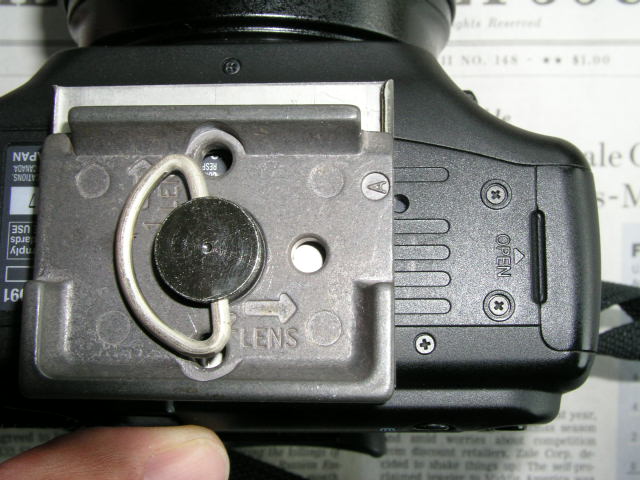
Note the finger hold which precludes the need for a screwdriver when attaching the plate to the base of the camera. The essence of this plate is that it has a small lip which abuts the base of the camera, replacing torque with physical restraint, as shown in the following snap:
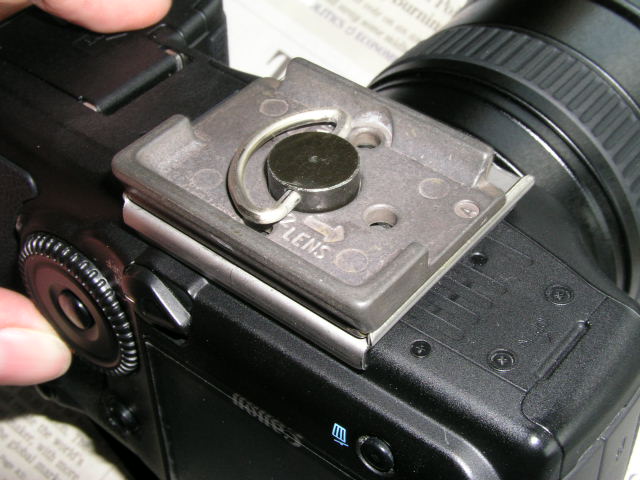
Depending on the design of your camera you may have to remove a small retaining circlip (E clip) for the bolt and flip the head around as I had to do this with the 5D which requires the lip abuts the rear of the camera. On others it may have to go towards the front, which is how it is shipped. No big deal, and clearly explained in the excellent instructions. While the camera plate does block access to the small battery compartment for the camera’s clock, in practice that has only to be accessed every five years or so, so it’s hardly an issue.
Here’s the whole thing mounted on my Linhof with its Leitz ball head:

In this underside view, with the camera oriented for portraits, you can see the small brass quick release lever – note the unrestricted access to the main battery compartment:
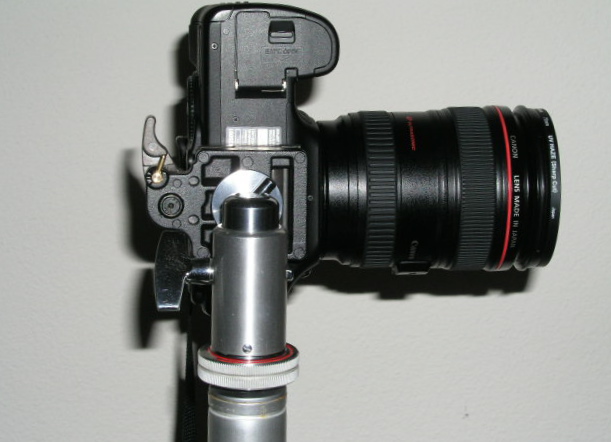
To attach the camera, you simply place the base plate with camera attached, front tilted slightly forward, into the tripod base. As you level the camera into the tripod base the camera plate depresses a small brass button in the tripod base which in turn releases the lever and locks the camera in place. You then rotate the brass safety lever which has the effect of locking the release lever in place. On one of the two tripod bases I bought the big lever would not click all the way home without manual assistance but after a few mount/dismount cycles all was well. Nonetheless, I would suggest you press the big lever home just in case, to ensure all is tight. Then operate the brass safety lock.
To remove the camera, release the safety lock and pull back on the big lever.
How does it compare size wise with the little Sima? See for yourself:
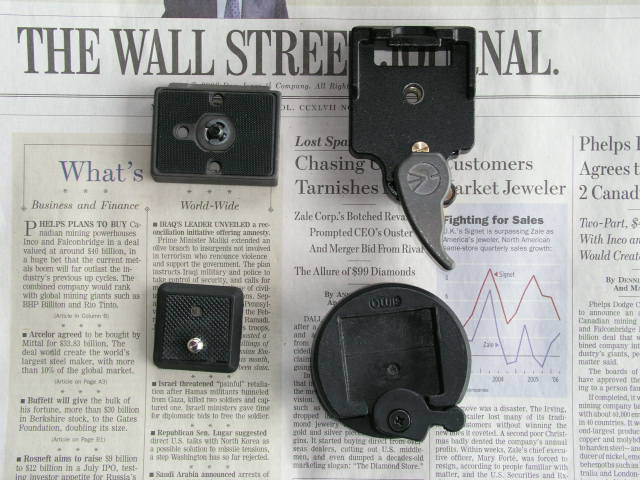
The overall size of the tripod base is much the same but the surface area of the camera plate is maybe twice the size. And no screwdriver is needed unlike with the Sima. The whole assembly is very rigid, even with a really heavy camera like the Crown Graphic with a heavy telephoto lens extended all the way.
If you are buying one of these, do realize that the tripod base comes with one plate (no lip) so buy additional plates as needed for your equipment. I used the two flat plates for my 4″ x 5″ Crown Graphic where the lip would not work owing to the large flat mounting surfaces involved; the Crown takes one plate either side so it can be switched effortlessly from landscape to portrait mode. One of the tripod plates went on the Linhof tripod, the other on the Manfrotto monopod. And lest you think that small Leitz ball head can’t handle it, let me assure you these things were probably used to raise the Golden Gate Bridge during construction. Doesn’t have to be big to be strong, and you can pick these up for some $100 used, which is a lot less than the going rate for all those exotic ball heads on the market. I mean, really. $750 for a ball head? That is God’s way of telling you that you have too much money.
Panasonic disappoints with the L1.
I should preface this by saying I have not used the newly announced Panasonic L1, so it’s really premature to criticize, but a review of the specificationss underwhelms.
I was really looking forward to this camera, hoping it would be the digital Leica all ex-Leica M users like me are waiting for, at a non-Leica price. They will sell for $2,000 with the Leica zoom lens. Not bad.

The disappointing Panasonic L1.
Now the ergonomics look promising. A real shutter speed dial, a pretty exciting Leica lens (alternatively designed by Leica or Panasonic, depending on where you read on the Panasonic web site) with manual zoom and iris controls, and a nice M-look camera body. Throw in image stabilization, a vibrator to shake off sensor dust and a 16:9 widescreen picture option and what’s not to like?
How about a lousy viewfinder? The L1 shares the prism optics of the Olympus E-330, which uses a side flapping mirror (like their Pen F half-frame film camera did some thrity years earlier) and mirrors in lieu of a pentaprism to turn the image right way round. Result? A very dim image. Don’t believe me. Check out the on line reviews.
How about a lousy sensor? Use it above 400 ISO and all is lost in noise. It’s the same sensor used in the E-330. Don’t believe me. Check out the on line reviews.
How about a very small image in the finder? It’s the same optics used in the E-330. Don’t believe me. Check out the on line reviews. And if you don’t know what I’m talking about, just look through a Canon 5D after trying a Rebel or 20D/30D. I have. Night and day. The L1/E330 is like the Rebel in this regard.
As for all that ‘live preview’ nonsense, why did they waste their time? No one needs this in a professional grade camera. And the E330 does it better, if you must have it, for less.
Too bad. I was kind of excited about that Leica lens. Guess we’ll have to wait for the Digital Leica M but, no, I’m not holding my breath. I’m just holding on to my wallet.